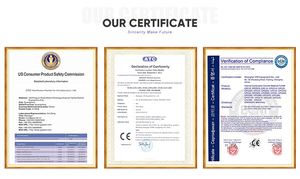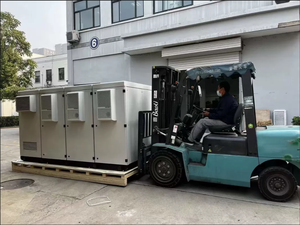
All categories
Featured selections
Trade Assurance
Buyer Central
Help Center
Get the app
Become a supplier

(4063 products available)














































There are several forms of a single-phase PWM inverter. They are categorized based on the switching method. These are the main forms of a PWM inverter.
It is the most common form of a single-phase PWM inverter. This inverter's switching pattern closely tracks a sine wave. Therefore, it allows the output voltage to have a nearly sinusoidal waveform. This helps reduce the output voltage's harmonic distortion. This feature improves efficiency in the inverter's functionalities.
Sinusoidal PWM works by varying the width of the pulses. This is done while keeping the pulses' frequency constant. The broader the pulse, the higher the voltage output.
This is a more complex and advanced method of pulse width modulation. However, it provides better performance in some applications than the sinusoidal method. It generates a 2D voltage space by considering the inverter as a vector. It means it can control the output voltage better and efficiently, reducing harmonic distortion.
SVPWM uses switching vectors that apply to the trajectory of a space vector. Its output voltage will be higher than the other PWM methods.
This type of PWM inverter operates independently from the main power grid. Buyers can use it to power remote areas or as a backup power source. It also can be integrated with renewable energy sources like solar or wind. This will provide reliable off-grid power.
This inveter utilizes a transformer to provide electrical isolation between the input and output circuits. It ensures the safe and reliable operation of the system. It protects against electrical hazards and surges. People often use it in applications requiring high-voltage or low-voltage safety.
These inverters are key components in diverse industrial applications. They convert DC to AC power for variable frequency motor drives, UPS, and more.
These inverters control speed and torque in electric motors. Mainly in industries like manufacturing and pumping systems, for example. They help power induction motors used in conveyors, pumps, and fans.
Using a PWM inverter will vary the motor speed according to application needs. This improves efficiency and reduces energy consumption.
These inverters are used to produce uninterruptable power supplies. This application protects critical equipment. These inverters convert battery or DC power into AC power. They ensure consistent power delivery even during outages.
There are many types of welding processes. But most modern welding machines rely on PWM. The PWM inverter will produce stable and adjustable power for precision welding. This feature ensures quality welds in the automotive, construction, and manufacturing sectors.
Battery maintenance is important for smooth industrial operations. PWM inverters in battery chargers control the charging process. It ensures batteries are charged efficiently without overloading or undercharging them.
This is ideal for industries relying heavily on backup power, such as telecommunications, data centers, and remote oil and gas fields.
Grid-connected inverters help stabilize and improve power quality in industrial settings. They smooth out voltage and current fluctuations. They also reduce harmonics and ensure a steady power supply for sensitive machinery.
Thus, industries will not experience any voltage drops or surges. This feature is vital for industries like semiconductor manufacturing, textile factories, or data centers that require stable power.
PWM inverters have different voltage configurations. There are 24V, 48V, and 220V voltage configurations. Their output AC voltage is about 230V +/- 15%. The output frequency is 50Hz +/- 1Hz. The output waveform is a sine wave that uses PWM as its mechanism.
For the pure sine wave inverter, the no-load output voltage is 12V +/- 5%. Its output voltage regulation is about 3%-5%. The output waveform has a distortion factor of < 2%. The temperature rises above ambient in < 25 degrees Celsius. The device has an IP21 or higher protection level. The device can operate continuously for > 8 hours.
In terms of housing and mounting, the inverter's housing is made from die-cast aluminum. It features cooling fins for efficient heat dissipation. The mounting brackets are made from durable steel for secure installations. The device is typically compact and lightweight for easy mobility.
In terms of display/control interfaces, the PWM inverters are normally digital. LCD displays monitor key parameters like voltage, current, and battery status. Users can adjust settings through button controls or remote interfaces. It is often connected to external sensors for temperature or load monitoring.
The efficiency of the inverter ranges from 80% to 95%. It depends on the load and operating conditions. The power factor is close to unity for industrial applications. Most models integrate features like automatic voltage regulation, surge capability for heavy loads, and protection against overheating, short circuits, and overloading.
Follow the correct installation steps for a safe and optimal operating inverter. First, Mounting the inverter in a properly ventilated area is key. There should be no obstruction to its airflow. The ambient temperature must be monitored to ensure the inverter does not overheat.
Then secure the inverter to its mounting bracket. Do not secure it too tightly as this will affect the inverter's operation. The location must be near to the power source and the area it will supply power to reduce the loss.
Next, connect the inverter to the power source. This is usually a battery bank or another DC power source. Use the correct wire size to prevent voltage drops or overheating. Connect the positive and negative wires to the corresponding terminals.
The inverter will have AC output terminals. These terminals are connected to the area the inverter will power. Follow the local electrical codes and regulations when connecting the inverter to avoid hazards.
Finally, turn on the inverter and monitor its output. Ensure all parameters are in the correct range. Refer to the inverter manual for guidance on proper settings. Also, perform regular maintenance on the inverter to check for dust or debris.
Regular maintenance of PWM inverters will extend their lifespan. It also ensures reliability. Here are the ways to maintain.
Do regular checks for any signs of overheating. It can cause major damage to the electronics inside the inverter. Check the ventilation system to ensure proper airflow. Also, monitor the temperature of the internal components. This can be done through temperature sensors or monitoring software.
Next, monitor the performance of the battery regularly. A degraded or poorly connected battery will affect the inverter's performance. Look out for swelling, unusual noises, or slow charging. Then clean the internal components of the inverter to prevent dust accumulation.
Dust can enter the inverter and affect its performance. Use a soft cloth or compressed air to remove dust from electronic parts. Regularly inspect the wiring and connections. Look for signs of corrosion or loose connections. This will help prevent electrical arcing or power loss.
Check for any software updates on the manufacturer's website. Inverters with software control will require regular updates to improve performance. Perform a visual inspection of the inverter for any cracks or damage to the housing. It can expose internal components to harmful elements.
Finally, refer to the manufacturer's guidelines for repairs. Do not attempt any repairs without professional guidance. The repair process must use genuine manufacturer parts only. It maintains the inverter's warranty and ensures quality performance.
There is a need to pay attention to these quality and safety characteristics. They ensure reliable performance while reducing operating costs.
Efficiency and power output
The inverter's efficiency will affect the quality of power produced. It will determine how much electrical energy is delivered to the area. This, in turn, affects the area it is powering. High-quality inverters with efficiency ratings over 90% are good. They will minimize energy loss during the inversion process.
Output waveform quality
A good PWM inverter produces a pure sine wave. It helps ensure the devices do not experience voltage drops or surges. This feature is key, especially when the load experiences high demand. A low total harmonic distortion rating also ensures quality.
Component quality
The internal components used in the PWM inverters play a huge role in their functionality. High-quality semiconductors, capacitors, and cooling systems contribute to reliable performance. They also impact the inverter's thermal management capacity. Inverters with low-quality internal components can overheat or suffer from electrical failures.
Grid synchronization
For inverters connected to the main power grid, proper synchronization is a must. It will ensure the inverter switches at the right time. It will prevent any issues with power quality and reliability.
Electrical hazards
PWM inverters operate at high voltages. It means they pose a risk of electrical shocks or even electrocution during maintenance or installation. The correct safety procedures when dealing with these inverters are a must. Also, the devices come with well-placed warning signs. They will inform people around the area of the dangers of electrical risks.
Overheating
Overheating can harm the people around as much as the inverter itself. It can damage the internal components and even cause electrical fires. Inverters with good thermal management systems will reduce the chances of overheating.
Fire risk
An electrical short or malfunctioning component can lead to fire outbreaks. The fires will cause serious injuries and property damage. These inverters usually have a fire risk warning. Proper ventilation and regular maintenance will reduce this risk.
Battery hazards
Inverters are often connected to batteries during closed-loop systems. These bytes contain hazardous chemicals like lead or sulfur. A battery with poor maintenance will explode, causing harm to nearby individuals.
Mechanical hazards
Many inverters have moving parts like fans or cooling systems. The moving parts can cause mechanical injury if not handled with care. Another risk comes from the installation or maintenance. There are sharp edges or tools that can injure the individual working on them.
A single-phase PWM inverter can power small to medium electrical devices. These devices do not require high power. It can hold up to televisions, computers, and gaming consoles. It can also hold kitchen appliances like microwaves and blenders. Other office devices like printers and fans and lights can also be powered.
The key advantage of SVPWM is its higher voltage utilization. It generates a better output with increased voltage and better space efficiency. It also reduces harmonics in the output waveform. This con improves the power quality and the smoothness of the connected motor.
There are no special installation requirements for these inverters. Just ensure they are mounted in well-ventilated areas with stable temperatures. The area they are mounted must have easy access for future maintenance. Also, minimize exposure to direct sunlight or water.
Routine maintenance includes cleaning the inverter, checking for dust or debris, and monitoring its temperature. Always ensure there is enough airflow around it. Also, inspect the wiring for loose connections or signs of wear. Look for software updates as required by the manufacturer.
Yes, these inverters can be used with renewable energy systems. They efficiently convert the generated DC power into AC power for area usage. The inverters regulate the output to match the area voltage requirements.